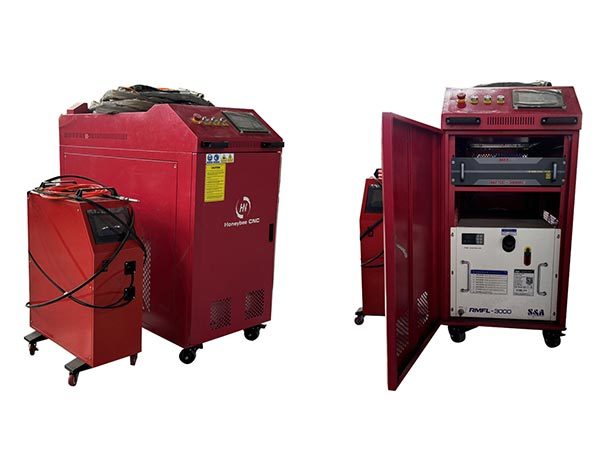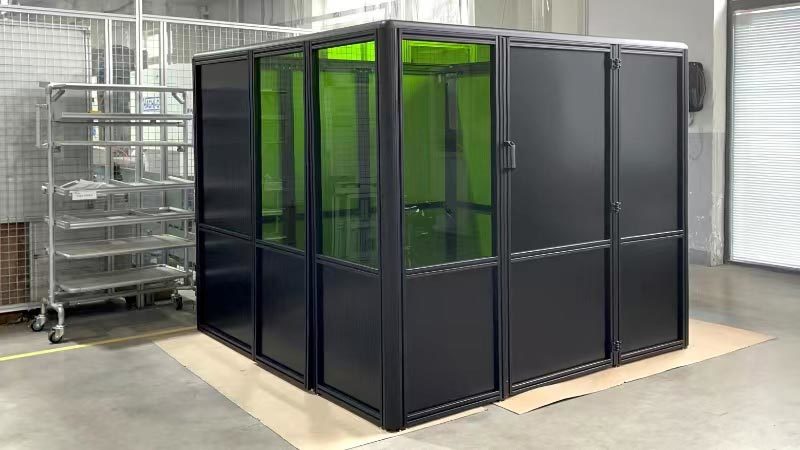News Center
What Materials Can a Laser Welding Machine Weld?
Laser welding machines are renowned for their precision, speed, and versatility, making them capable of joining a diverse range of materials. Directly answering the question: laser welders can effectively weld most metals and alloys, certain types of plastics, and even combinations of dissimilar materials.
The high energy density and precise control offered by laser beams allow for joining materials that might be difficult or impossible to weld using traditional methods. Below, we explore the materials, processes, applications, and essential considerations for laser welding.

Materials Commonly Welded by Laser
Metals and Alloys:
Laser welding excels with metallic materials, including:
- Stainless Steels: Various grades are readily weldable, producing high-quality, strong joints often used in medical, food-grade, and aerospace applications.
- Carbon Steels: Both low and high carbon steels can be welded, though high carbon varieties may require pre- or post-heating to prevent cracking.
- Aluminum Alloys: While challenging due to high reflectivity and thermal conductivity, lasers (especially fiber lasers) effectively weld many aluminum alloys, crucial in automotive and aerospace.
- Titanium Alloys: Ideal for laser welding due to their reactivity. The process, often done with inert gas shielding, yields strong, clean welds for aerospace, medical implants, and chemical processing.
- Copper Alloys: Similar to aluminum, copper's high reflectivity and conductivity pose challenges, but specialized laser parameters and techniques enable successful welding, vital for electronics and electrical components.
- Nickel Alloys (e.g., Inconel, Hastelloy): These high-performance alloys used in extreme environments (temperature, corrosion) are well-suited for laser welding.
- Precious Metals: Gold, silver, and platinum can be precisely welded with minimal heat input, essential for jewelry making and repair.
Plastics:
Laser welding isn't suitable for all plastics, but it works very well for certain thermoplastics. The most common method is transmission laser welding, where one plastic layer is transparent to the laser wavelength, and the underlying layer is absorbent. The laser passes through the top layer, heats the absorbent layer at the interface, and melts both materials together. Common examples include:
- Polycarbonate (PC)
- Acrylic (PMMA)
- Polypropylene (PP)
- Polyamide (PA)
- ABS
Dissimilar Materials:
One of the significant advantages of laser welding is its ability to join certain dissimilar materials, though careful parameter control and understanding of metallurgy are required. Examples include:
- Copper to Stainless Steel
- Steel to Nickel Alloys
- Certain Metals to specific Plastics (less common, specialized techniques)
Laser Welding Processes and Techniques
Laser welding isn't a single technique but encompasses several methods depending on the required power density and desired outcome:
- Conduction Mode Welding: Uses lower power density. The laser beam heats the surface of the material above its melting point, but below vaporization. Heat conducts into the material, creating a wide, shallow weld, often with a smooth surface finish. Good for aesthetic welds or joining thin materials where penetration isn't the primary goal.
- Keyhole Mode Welding (Deep Penetration): Uses high power density. The laser beam rapidly heats the material surface to its vaporization point, creating a cavity (keyhole) filled with metal vapor (plasma). This keyhole allows the laser energy to penetrate deep into the material as the beam moves, resulting in narrow, deep welds with high aspect ratios. Ideal for joining thicker sections or achieving strong structural bonds.
- Hybrid Laser Arc Welding (HLAW): Combines laser welding with an arc welding process (like MIG/GMAW or TIG/GTAW). This leverages the deep penetration of the laser and the gap-bridging capabilities or filler metal addition of arc welding, often resulting in faster speeds and improved tolerance to joint fit-up variations.
Applications and Industries
The versatility of laser welding leads to its use in numerous fields:
- Automotive: Body panels, chassis components, powertrain parts, electric vehicle battery casings and connections, airbags.
- Aerospace: Engine components, structural elements, sensor assemblies.
- Medical Devices: Surgical instruments, pacemakers, implantable devices (titanium casings), diagnostic equipment components.
- Electronics: Battery welding, sensor housings, microelectronic component joining, connector pins.
- Tool and Die: Repairing molds and dies with high precision.
- Jewelry: Chain repair, ring sizing, intricate component joining.
- General Manufacturing: Joining sheet metal, pipes, and various components requiring high precision and speed.
Common Consumables (Wear Parts) in Laser Welding
While laser sources themselves are durable, certain components in the beam delivery system are consumables that require periodic inspection and replacement:
-
Protective Lens / Cover Glass:
- Function: This is the most common consumable. It's a transparent optical window positioned just before the focusing optics, protecting them from spatter, fumes, and debris generated during welding.
- Replacement Need: Becomes dirty, cloudy, pitted, or cracked over time due to spatter adhesion or heat absorption. A damaged or dirty protective lens reduces laser power delivery, affects weld quality, and can lead to catastrophic failure of the expensive focusing lens.
- How to Replace: Follow manufacturer instructions carefully. Typically involves stopping the laser, accessing the cutting head, carefully removing the old lens holder/cartridge, cleaning the area, inserting the new lens (handling only by the edges, often wearing gloves), and securing it properly.
-
Nozzle:
- Function: Directs the shielding gas flow coaxially or side-on to the weld zone, protecting the molten pool from the atmosphere. Its orifice size and shape influence gas flow dynamics.
- Replacement Need: Can become clogged with spatter, deformed by heat or minor collisions, or worn, affecting gas coverage and potentially interfering with the laser beam.
- How to Replace: Usually straightforward – unscrew the old nozzle, check the threads and seating surface for cleanliness, and screw on the new one. Ensure the correct type and size are used for the application.
Shielding Gases Used in Laser Welding
Shielding gases are crucial in most laser welding applications to protect the molten weld pool and surrounding heat-affected zone from atmospheric oxygen and nitrogen, which can cause porosity, embrittlement, and poor weld quality. Common gases include:
- Argon (Ar): An inert gas, widely used for many materials like stainless steel, titanium, and aluminum. It provides good shielding coverage due to its density and is relatively cost-effective.
- Helium (He): Another inert gas. It has higher thermal conductivity than Argon, which can be beneficial for welding highly conductive materials like copper and aluminum, allowing for deeper penetration or faster speeds. It's often used in mixtures with Argon (e.g., 75% Ar / 25% He) to balance properties and cost. Helium is less dense, requiring higher flow rates for equivalent coverage.
- Nitrogen (N₂): Can be used for certain materials, like austenitic stainless steels, where it can sometimes improve weld properties or corrosion resistance. However, it can form undesirable nitrides in other materials (like ferritic steels or titanium). It's often cheaper than Argon.
- Gas Mixtures: Specific mixtures (e.g., Argon with small amounts of O₂ or CO₂ for certain steels, or Ar/He blends) are sometimes used to optimize weld pool shape, penetration, or arc stability (in hybrid processes).
The choice of gas depends heavily on the material being welded and the desired weld characteristics.
Enhancing Safety: Laser Safety Barriers


Laser welding systems, especially higher-power ones, emit intense radiation (often invisible) that can cause severe eye and skin damage upon direct or scattered exposure. To ensure operator safety and comply with regulations, Laser Safety Barriers are essential, particularly in automated or semi-automated setups. These barriers typically feature:
- Physical Enclosure: A robust structure surrounding the laser welding zone, physically preventing personnel from entering the hazardous area during operation.
- Laser Safety Glass: Special viewing windows integrated into the barrier walls. This glass is rated to block the specific wavelength(s) of the laser being used (indicated by its Optical Density or OD rating), allowing operators to safely monitor the process from outside the enclosure.
- Safety Interlocks: Electromechanical switches connected to all access doors and panels of the barrier. If any door or panel is opened, the interlock system immediately sends a signal to halt the laser emission, preventing accidental exposure to the beam.
Using a properly designed and interlocked laser safety barrier is a critical measure for protecting personnel when working with industrial laser welding equipment.













